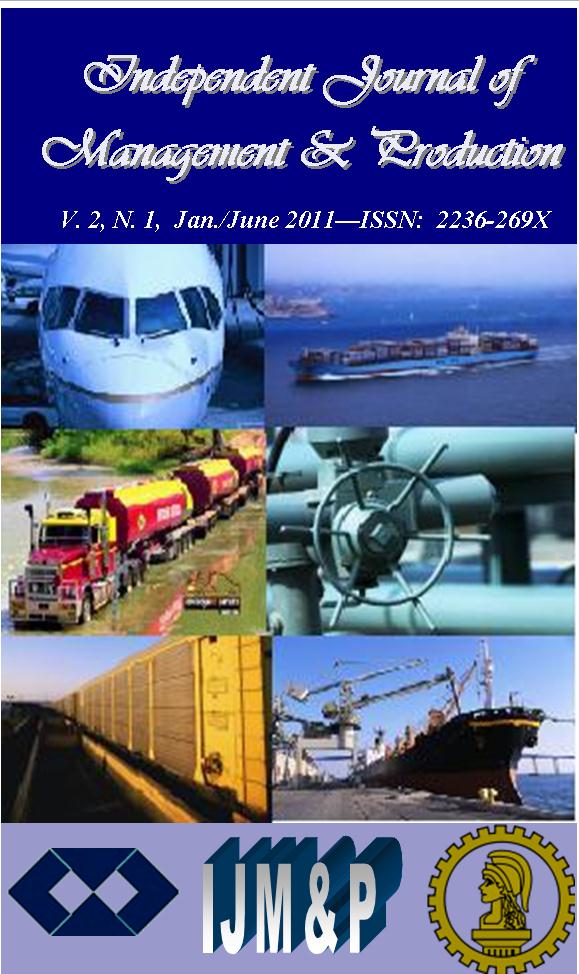Utilizando o método todim para avaliar as melhores empresas para trabalhar
Main Article Content
Abstract
Este artigo expõe uma nova proposta de ordenação das 5 melhores empresas para trabalhar em termos de qualidade do ambiente de trabalho e qualidade na gestão de pessoas utilizando-se do método TODIM como suporte científico para tal. A ordenação inicial, proposta pela revista Você/SA Exame, utiliza como método classificador o índice de felicidade no trabalho, uma soma ponderada de índices resultantes da percepção dos funcionários, das práticas da empresa e da constatação feita por jornalistas em visitas às empresas.Este trabalho, que utiliza o método TODIM, considera esses itens como critérios de avaliação e realiza uma análise comparativa das alternativas. Ao final, é executada uma comparação entre as ordenações e uma análise de sensibilidade, analisando as especificidades de cada método de ordenação e a consistência de seus resultados.
Downloads
Article Details
1. Proposal of Policy for Free Access Periodics
Authors whom publish in this magazine should agree to the following terms:
a. Authors should keep the copyrights and grant to the magazine the right of the first publication, with the work simultaneously permitted under the Creative Commons Attribution-NonCommercial-ShareAlike 4.0 that allows the sharing of the work with recognition of the authorship of the work and initial publication in this magazine.
b. Authors should have authorization for assuming additional contracts separately, for non-exclusive distribution of the version of the work published in this magazine (e.g.: to publish in an institutional repository or as book chapter), with recognition of authorship and initial publication in this magazine.
c. Authors should have permission and should be stimulated to publish and to distribute its work online (e.g.: in institutional repositories or its personal page) to any point before or during the publishing process, since this can generate productive alterations, as well as increasing the impact and the citation of the published work (See The Effect of Free Access).
Proposal of Policy for Periodic that offer Postponed Free Access
Authors whom publish in this magazine should agree to the following terms:
a. Authors should keep the copyrights and grant to the magazine the right of the first publication, with the work simultaneously permitted under the Creative Commons Attribution-NonCommercial-ShareAlike 4.0 [SPECIFY TIME HERE] after the publication, allowing the sharing of the work with recognition of the authorship of the work and initial publication in this magazine.
b. Authors should have authorization for assuming additional contracts separately, for non-exclusive distribution of the version of the work published in this magazine (e.g.: to publish in institutional repository or as book chapter), with recognition of authorship and initial publication in this magazine.
c. Authors should have permission and should be stimulated to publish and to distribute its work online (e.g.: in institutional repositories or its personal page) to any point before or during the publishing process, since this can generate productive alterations, as well as increasing the impact and the citation of the published work (See The Effect of Free Access).
d. They allow some kind of open dissemination. Authors can disseminate their articles in open access, but with specific conditions imposed by the editor that are related to:
Version of the article that can be deposited in the repository:
Pre-print: before being reviewed by pairs.
Post-print: once reviewed by pairs, which can be:
The version of the author that has been accepted for publication.
The editor's version, that is, the article published in the magazine.
At which point the article can be made accessible in an open manner: before it is published in the magazine, immediately afterwards or if a period of seizure is required, which can range from six months to several years.
Where to leave open: on the author's personal web page, only departmental websites, the repository of the institution, the file of the research funding agency, among others.
References
GOMES, L. F. A. M.; LIMA, M. M. P. P.(1992ª) TODIM: Basics and application to multicriteria ranking of projects with environmental impacts. Foundations of Computing and Decision Sciences, v. 16, n. 4, p. 113–127.
GOMES, L. F. A. M.; LIMA, M. M. P. P. (1992b) From modeling individual preferences to multicriteria ranking of discrete alternatives: A look at Prospect Theory and the additive difference model. Foundations of Computing and Decision Sciences, v. 17, n. 3, p. 171–184.
GOMES, L. F. A. M.; RANGEL, L. A. D. (2007) An application of the TODIM method to the multicriteria rental evaluation of residential properties, European Journal of Operational Research, doi:10.1016/j.ejor.2007.10.046.
GUIA VOCÊ/SA EXAME (2009) As melhores empresas para você trabalhar. São Paulo: Abril. Disponível em: < http://vocesa.abril.com.br/melhoresempresas/> . Acesso em: 15 mai 2010.
KAHNEMAN, D.; TVERSKY, A. (1979) Prospect theory: An analysis of decision under risk. Econometrica, n. 47.
MARANHÃO, F. J. C. (2006) A exploração de gás natural em Mexilhão: análise multicritério pelo método TODIM. 92 f. Dissertação (Mestrado Profissionalizante em Administração) - Faculdade de Economia e Finanças, IBMEC, Rio de Janeiro.
ROMERO, C. (1993) Teoría de la decisión multicriterio: Conceptos, técnicas y aplicaciones. Madrid: Alianza Editorial S.A., Alianza Universidad Textos, p. 195.
ROY, B.; BOUYSSOU, D. (1993) Aide Multicritère à la Décision: Méthodes et Cas. Paris: Ed. Econômica, p. 695.
TROTTA, L. T. F.; NOBRE, F. F.; GOMES, L. F. A. M. (1999) Multi-criteria decision making – An approach to setting priorities in health care. Statistics in Medicine, n. 18, p. 3345–3354.
VINCKE, P. (1989) L'aide multicritère à la dècision. Bruxelles: Éditions de l´Université de Bruxelles, p. 179.





